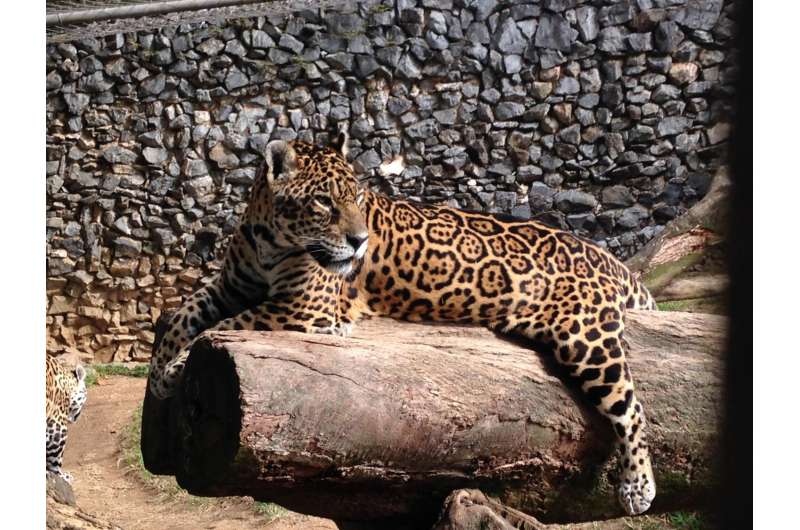Jaguar individual, called 'Vagalume' ('Firefly' in Portuguese), whose genome was sequenced. Credit: Rodrigo Teixeira
(Phys.org)—A large international team of researchers has conducted a genetic analysis and comparison of the world's biggest cats to learn more about their history. In their paper published on the open source site Science Advances, the team describes their work mapping the genome of the jaguar and comparing the results with other big cats.
The jaguar is the largest wild cat in the Americas, and as the researchers note, it is also in danger of becoming extinct. While some of the reasons for the rapid decline in jaguar populations are obvious, others are not so clear. That is why the team embarked on a five-year mission to study the animals hoping to learn how to save them.
One of the avenues of research involved mapping the genome of the jaguar—such mapping for other big cats had already been done. That allowed the researchers to compare markers between cats belonging to the genus Panthera, which, in addition to jaguars, also includes tigers, lions, snow leopards and regular leopards. Also, because so much genetic work has been done on the common house cat, they, too, were included in the study.
The researchers report that they found over 13,000 genes that were similar through all of the species included in the study. They also found that the cats all diverged from a single ancestor approximately 4.6 million years ago—one that was apparently most like the modern leopard. The team also found that all of the species populations have also declined over the past 300,000 years, which means lower genetic diversity.
Species tree of the genus Panthera estimated from genome-wide data. All five extant species are represented as follows: lion (Panthera leo), leopard (Panthera pardus), jaguar (Panthera onca), snow leopard (Panthera uncia), and tiger (Panthera tigris). Numbers above branches indicate the estimated age [in million years ago (Ma)] of the adjacent node, averaged across all genomic windows (100-kb window size, 100-kb steps) that conform to the species tree (95% highest posterior density interval below the respective branch). Colored rectangles on terminal branches indicate phenotypic categories affected by species-specific episodes of positive selection. Credit: Figueiró et al., Sci. Adv. 2017;3: e1700299
One surprise they found was that the big cats have all engaged in cross-breeding multiple times over the course of their history, and because of that, have evolved new features that have proved useful in other areas. They suspect, for example, that the jaguar, which has the strongest bite of all the big cats, found itself with a larger head after breeding with lions—that may have led to a bite strength increase, which made it possible for them to hunt better protected animals in the New World.
More information: Henrique V. Figueiró et al. Genome-wide signatures of complex introgression and adaptive evolution in the big cats, Science Advances (2017). DOI: 10.1126/sciadv.1700299
Abstract
The great cats of the genus Panthera comprise a recent radiation whose evolutionary history is poorly understood. Their rapid diversification poses challenges to resolving their phylogeny while offering opportunities to investigate the historical dynamics of adaptive divergence. We report the sequence, de novo assembly, and annotation of the jaguar (Panthera onca) genome, a novel genome sequence for the leopard (Panthera pardus), and comparative analyses encompassing all living Panthera species. Demographic reconstructions indicated that all of these species have experienced variable episodes of population decline during the Pleistocene, ultimately leading to small effective sizes in present-day genomes. We observed pervasive genealogical discordance across Panthera genomes, caused by both incomplete lineage sorting and complex patterns of historical interspecific hybridization. We identified multiple signatures of species-specific positive selection, affecting genes involved in craniofacial and limb development, protein metabolism, hypoxia, reproduction, pigmentation, and sensory perception. There was remarkable concordance in pathways enriched in genomic segments implicated in interspecies introgression and in positive selection, suggesting that these processes were connected. We tested this hypothesis by developing exome capture probes targeting ~19,000 Panthera genes and applying them to 30 wild-caught jaguars. We found at least two genes (DOCK3 and COL4A5, both related to optic nerve development) bearing significant signatures of interspecies introgression and within-species positive selection. These findings indicate that post-speciation admixture has contributed genetic material that facilitated the adaptive evolution of big cat lineages.
Journal information: Science Advances
© 2017 Phys.org

![Species tree of the genus Panthera estimated from genome-wide data. All five extant species are represented as follows: lion (Panthera leo), leopard (Panthera pardus), jaguar (Panthera onca), snow leopard (Panthera uncia), and tiger (Panthera tigris). Numbers above branches indicate the estimated age [in million years ago (Ma)] of the adjacent node, averaged across all genomic windows (100-kb window size, 100-kb steps) that conform to the species tree (95% highest posterior density interval below the respective branch). Colored rectangles on terminal branches indicate phenotypic categories affected by species-specific episodes of positive selection. Credit: Figueiró et al., Sci. Adv. 2017;3: e1700299 Genome study offers clues about history of big cats](https://scx1.b-cdn.net/csz/news/800a/2017/597204176c51b.jpg)






















